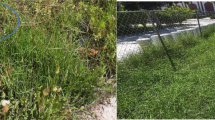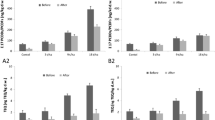Abstract
2,4-Dichlorophenol (2,4-DCP) is considered as an important pollutant because of its high toxicity and wide distribution in wastewaters. Innocuous remediation technologies have been studied for the removal of this pollutant. This study investigated the feasibility of using garlic roots as a plant system for the removal of 2,4-DCP. The optimal conditions for its removal were established based on orthogonal experiments (OA25 matrix). Significant factors that affect removal efficiency, arranged from high to low importance, include pH, reaction time, 2,4-DCP concentration, and H2O2 concentration. In addition, garlic roots could be re-used for as much as three consecutive cycles. The decrease in pH and the increase of Cl− ion content in the post-removal solutions indicated that 2,4-DCP dehalogenation occurred during transformation. Changes in the deposition pattern of lignin in roots exposed to 2,4-DCP suggested that several of the products deposited were lignin-type polymers. The acute toxicity test revealed that the post-removal solutions were less toxic than the parent solutions. Therefore, garlic roots have considerable potential to effectively and safely remove 2,4-DCP from wastewater.






Similar content being viewed by others
References
Agostini E, Coniglio MS, Milrad SR, Tigier HA, Giulietti MA (2003) Phytoremediation of 2,4-dichlorophenol by Brassica napus hairy roots. Biotechnol Appl Biochem 37:139–144
Angelini VA, Orejas J, Medina MI, Agostini E (2011) Scale up of 2,4-dichlorophenol removal from aqueous solutions using Brassica napus hairy roots. J Hazard Mate 185:269–274
Angelini VA, Agostini E, Medina MI, González PS (2014) Use of hairy roots extracts for 2,4-DCP removal and toxicity evaluation by Lactuca sativa test. Environ Sci Pollut Res 21:2531–2539
Antonopoulos VT, Rob A, Ball AS, Wilson MT (2001) Dechlorination of chlorophenols using extracellular peroxidases produced by Streptomyces albus ATCC 3005. Enzyme Microb Tech 29:62–69
Baayen R, Ouellette G, Rioux D (1996) Compartmentalization of decay in carnations resistant to Fusarium oxysporum f. sp. dianthi. Phytopathology 86:1018–1031
Barrena R, Casals E, Colón J, Font X, Sánchez A, Puntes V (2009) Evaluation of the ecotoxicity of model nanoparticles. Chemosphere 75:850–857
Braber JM (1980) Catalase and peroxidase in primary bean leaves during development and senescence. Z Pflanzenphysiol 97:135–144
Buchanan ID, Nicell JA (1997) Model development for horseradish peroxidase catalyzed removal of aqueous phenol. Biotechnol Bioeng 54(3):251–261
Chai X-S, Hou QX, Luo Q, Zhu JY (2004) Rapid determination of hydrogen peroxide in the wood pulp bleaching streams by a dual-wavelength spectroscopic method. Anal Chim Acta 507:281–284
Chen ZF, Zhao Y, Guo TZ, Gu L (2013) Accumulation and phytoavailability of hexachlorocyclohexane isomers and cadmium in Allium sativum L. under the stress of hexachlorocyclohexane and cadmium. Bull Environ Contam Toxicol 90:182–187
Coniglio MS, Busto VD, Gonzále PS, Medina MI, Milrad S, Agostini E (2008) Application of Brassica napushairy root cultures for phenol removal from aqueous solutions. Chemosphere 72:1035–1042
De Araujo BS, Dec J, Bollag JM, Pletsch M (2006) Uptake and transformation of phenol and chlorophenols by hairy root cultures of Daucus carota, Ipomoea batatas and Solanum aviculare. Chemosphere 63:642–651
Dec J, Bollag JM (1994) Dehalogenation of chlorinated phenols during oxidative coupling. Environ Sci Technol 28:484–490
Doran PM (2009) Application of plant tissue cultures in phytoremediation research: incentives and limitations. Biotechnol Bioeng 103:60–76
Ghioureliotis M, Nicell JA (1999) Assessment of soluble products of peroxidase-catalyzed polymerization of aqueous phenol. Enzyme Microb Technol 25:185–193
Gong P, Wilke BM, Fleischmann S (1999) Soil-based phytotoxicity of 2,4,6-trinitrotoluene (TNT) to terrestrial higher plants. Arch Environ Contam Toxicol 36:152–157
González PS, Capozucca CE, Tigier HA, Milrad SR, Agostini E (2006) Phytoremediation of phenol from wastewater, by peroxidases of tomato hairy root cultures. Enzyme Microb Tech 39:647–653
González PS, Agostini E, Milrad S (2008) Comparison of the removal of 2,4-dichlorophenol and phenol from polluted water, by peroxidases from tomato hairy roots, and protective effects of polyethylene glycol. Chemosphere 70:982–989
Hinner ANP, Hernandez-Ruiz J, Arnao MB, García-Canovas F, Acosta M (1996) A comparative study of the purity, enzyme activity, and inactivation by hydrogen peroxide of commercially available horseradish peroxidase isoenzymes A and C. Biotechnol Bioeng 50:655–662
Hose E, Clarkson DT, Steudle E, Schreiber L, Hartung W (2001) The exodermis: a variable apoplastic barrier. J Exp Bot 52:2245–2264
Ikehata K, Nicell JA (2000) Color and toxicity removal following tyrosinasecatalyzed oxidation of phenols. Biotech Pr 16(4):533–540
Jakubowski H (2003) On the health benefits of Allium sp. Nutrition 19(2):167–168
Klibanov AM, Alberti B, Morris E, Felshin L (1980) Enzymatic removal of toxic phenols and anilines from waste waters. J Appl Biochem 2:414–421
Laurenti E, Ghibaudi E, Ardissone S, Ferrari RP (2003) Oxidation of 2,4-dichlorophenol catalyzed by horseradish peroxidase: characterization of the reaction mechanism by UV-visible spectroscopy and mass spectrometry. J Inorg Biochem 95:171–176
Marzouki SM, Almagro L, Sabater-Jara AB, Ros BA, Pedreño MA (2010) Kinetic characterization of a basic peroxidase from garlic (Allium sativum L.) cloves. J Food Sci 75(9):740–746
Suresh B, Ravishankar GA (2004) Phytoremediation—a novel and promising approach for environmental clean-up. Crit Rev Biotechnol 24:97–124
Talano MA, Agostini E, Medina MI, Reinoso H, Tordableb MC, Tigiera HA, Forchetti SM (2006) Changes in lignosuberization of cell walls of tomato hairy roots produced by salt treatment: the relationship with the release of a basic peroxidase. J Plant Physiol 163:740–749
Talano MA, Frontera S, González P, Medina MI, Agostini E (2010) Removal of 2,4-diclorophenol from aqueous solutions using tobacco hairy root cultures. J Hazard Mater 176:784–791
Talano MA, Busso DC, Paisio CE, González PS, Purro SA, Medina MI, Agostini E (2012) Phytoremediation of 2,4-dichlorophenol using wild type and transgenic tobacco plants. Environ Sci Pollut Res 19:2202–2211
Ucisika AS, Trapp S, Kusk KO (2007) Uptake, accumulation, phytotoxicity, and removal of 2,4-dichlorophenol in willow trees. Environ Toxicol Chem 26(6):1165–1171
Wevar Oller AL, Agostini E, Talano MA, Capozucca C, Milrad SR, Tigier HA, Medina MI (2005) Overexpression of a basic peroxidase in transgenic tomato (Lycopersicon esculentum Mill. cv. Pera) hairy roots increases phytoremediation of phenol. Plant Sci 169:1102–1111
Zhang G, Nicell JA (2000) Treatment of aqueous pentachlorophenol by horseradish peroxidase and hydrogen peroxide. Water Res 34:1629–1637
Acknowledgments
This study was supported by the 12th Five-Year Plan Project of Science and Technology Support, China (2014BAD14B02); the Natural Science Research Foundation of Jilin Province of China (20140520155JH); and the National Natural Science Foundation of China (41471252).
Author information
Authors and Affiliations
Corresponding author
Rights and permissions
About this article
Cite this article
Wang, Y., Zhang, JX., Ren, HJ. et al. Phytoremediation potentiality of garlic roots for 2,4-dichlorophenol removal from aqueous solutions. Appl Microbiol Biotechnol 99, 3629–3637 (2015). https://doi.org/10.1007/s00253-014-6277-3
Received:
Revised:
Accepted:
Published:
Issue Date:
DOI: https://doi.org/10.1007/s00253-014-6277-3




